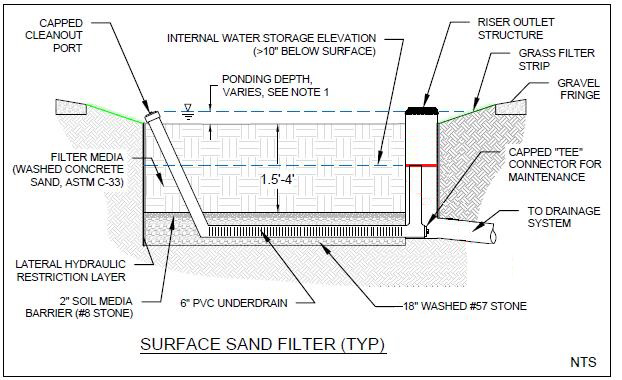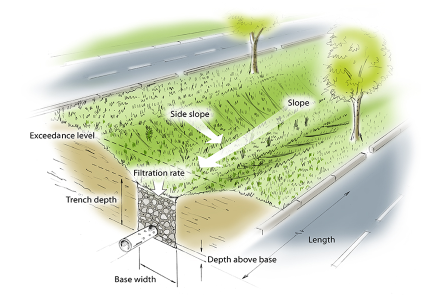Swale stormwater controls may be used to model a range of stormwater controls including, but not limited to, wet swales, vegetated, dry swales, French drains, filter trenches, infiltration trenches, trench dry wells, wadis, all with and without under drain pipes.
Total Volume
The Total Volume value shown in the bottom-right corner of the data form shows the volume available in the system up to the Freeboard elevation.
Dimensions
The Dimensions tab has the following fields:

Swale
The depth within the Swale area is determined from two of the following three parameters, with the third automatically calculated based on the option selected:
- Exceedance Elevation - Represents the elevation (above datum) of the stormwater control above which flooding is reported. This may be the elevation that interacts with the ground surface or the top of an embankment, whichever is higher. An overflow or spillway crest elevation may be specified at a lower elevation as part of the outlet control details. If a Surface Data model (TIN) is present the Exceedance Elevation will automatically be picked up from the center of the icon or from the lowest point on the bioretention perimeter if an outline has been drawn. This combined with the Freeboard setting allows a Status of Flood Risk to be assigned to the system on the Summary. For stormwater controls on a slope the Exceedance elevation applies to the downstream (lowest) end. Above the Exceedance Elevation, water will be stored above the ground and then allowed to drain back into the network. The ponding area used for the flooded volume is the area the Swale occupies on the plan.
- Depth - Represents the depth of the Swale.
- Base Elevation - Represents the elevation (above datum) of the base of the Swale (or top of the Trench if used). For structures on a slope the invert elevation applies to the downstream (lowest) end.
The cross sectional area of the Swale area is then determined from the Top Width, Side Slope and Base Width. As per the depth calculation when two values are specified the third will automatically be calculated based on the option selected:
- Top Width - The width at the top of the Swale.
- Side Slope - Side Slope of the Swale.
- Base Width - The width at the bottom of the Swale. This also gives the width of the Trench section if it is being used.
Freeboard - Controls how close to the specified Exceedance Elevation the water must reach before the Status (on the Summary) shows Flood Risk.
Length - The maximum path length through the stormwater control, used only for the purpose of calculating Time of Travel. The Length will be automatically set from the dimensions of the stormwater control unless over typed, in which case it is set to "user specified ".
Longitudinal Slope - Slope along the length of the stormwater control. Note that unlike other stormwater controls, it is mandatory to have a non-zero longitudinal slope.
Filtration Rate - Defines the filtration rate from the Swale into the Trench if used.
Friction Scheme - Specifies the formula used to calculate velocity and time of travel. Select from: Manning's, and Colebrook-White. The variable below the combo box depends on the option selected.
n - Manning’s n roughness value. Used by the Manning Formula equation to calculate the velocity and therefore time of travel when using the Manning's option.
Roughness - Colebrook-White roughness value. Used by the Colebrook-White Formula equation to calculate the velocity and therefore time of travel when using the Colebrook-White option.
Trench
Trench Depth - The depth of the trench
Trench Porosity - The percentage of the trench that is available for storage. This is dictated by the type of fill material that is used. I.e. Typically 30% for rubble.
Under Drain On: Specifies whether a pipe or conduit under drain is present in the lowest layer of the filter area. If under drain is on the following can be specified:
Height Above Base - Height of the invert of the pipe above the base of the Drainage System.
Diameter - Defines the diameter of the pipe/s.
No. of Barrels - Represents the number of pipes.
Friction Scheme - Specifies the formula used to calculate velocity and time of travel. Select from: Manning's, and Colebrook-White. The variable below the combo box depends on the option selected.
n - Manning’s n roughness value. Used by the Manning Formula equation to calculate the velocity and therefore time of travel when using the Manning's option.
Roughness - Colebrook-White roughness value. Used by the Colebrook-White Formula equation to calculate the velocity and therefore time of travel when using the Colebrook-White option.
Release Height - Height above the invert of the under drain pipe at which the water is released (marked in red on the diagram below). This is commonly used to create a saturated zone.

Sizing Calculator

The Sizing Calculator option allows the user to re-size the Swale by specifying a volume and a parameter to modify to achieve that volume. The Sizing Calculator is discussed in more detail in the Stormwater Control Sizing Calculator section.
Inlets
Explore the Inlets page for more details on the different types of Inlets that can be specified.
Outlets
Explore the Outlets page for more details on the different types of Outlets that can be specified.
Advanced
The Advanced tab has the following fields:

Swale
Base Infiltration Rate - Defines the rate of infiltration through the base of the filter area. This should be determined from a performance site test.
Side Infiltration Rate - Defines the rate of infiltration through the sides of the filter area. This should be determined from a performance site test.
Porosity - The percentage of the swale that is available for storage. This is dictated by the type of fill material that is used. I.e. 100% if empty or typically 30% for rubble.
Trench
Base Infiltration Rate - Defines the rate of infiltration through the base of the filter area. This should be determined from a performance site test.
Side Infiltration Rate - Defines the rate of infiltration through the sides of the filter area. This should be determined from a performance site test.
Conductivity - The conductivity rate is used for the calculation of both the horizontal and vertical transfer of the water in the sub-surface layers. Please refer to the Help topic on Conductivity rates for guidance on how to set these values depending on the type of material.
Safety Factor - Reduces the infiltration rate during the analysis to account for silting up or poor maintenance. This is required for the UK.
Pollution
The Pollution tab has the following fields:

Name - Name of pollutants. This is populated based on the Pollutants set up as part of the Site Data.
Aspect - A section that details if the pollutant is Swale or Trench.
Background Concentration - Value below which the pollution concentration cannot fall during analysis. When concentration reaches this elevation, no further removal occurs.
Method - Percentage Removal or First Order Decay method can be chosen. Click on the links for more information about each method.
Percentage Removal - Available if Percentage Removal entered. The value entered will be deducted from the Inflow into the system.
τ - The decay time constant or (mean) lifetime of the pollutant. It can be entered manually or calculated from the decay constant or decay half-life. See Pollutant Removal Method - First Order Decay for more details.

